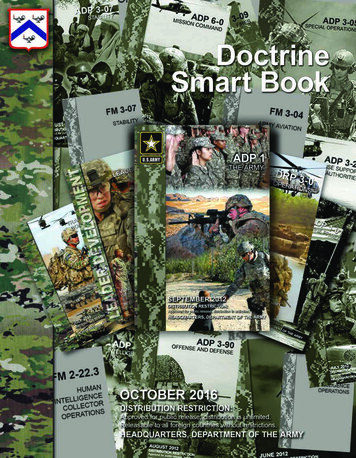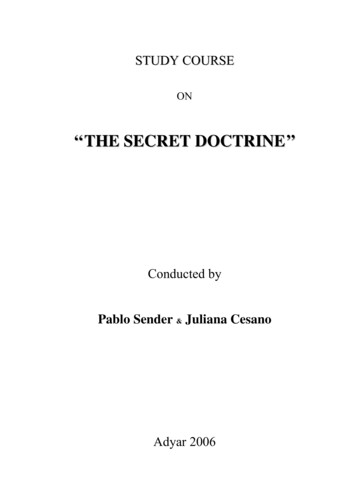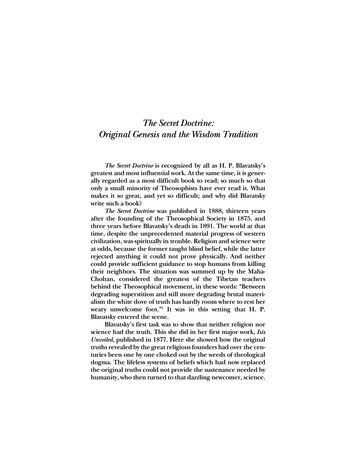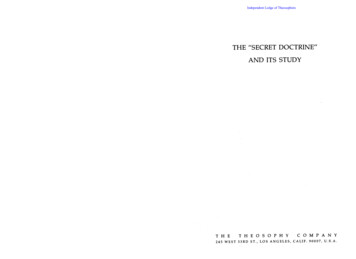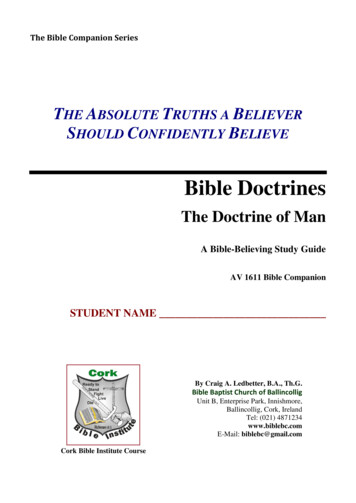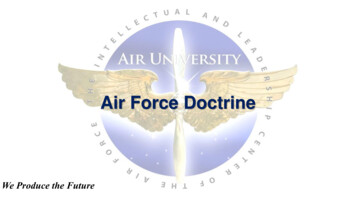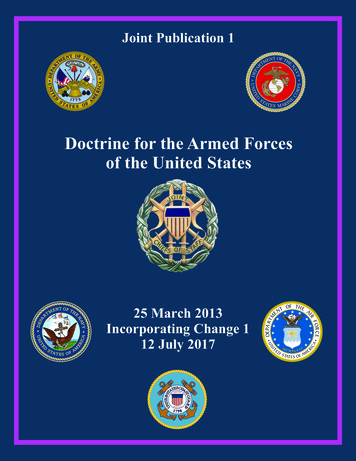
Transcription
ENTTMHIT OF T HS W E' L LDEFEENDARDSTMTEERU NII CA MY DE PARJoint Publication 1AT E S O FADoctrine for the Armed Forcesof the United States25 March 2013Incorporating Change 112 July 2017
Joint Publication 1, Doctrine for the Armed Forces of the United States, is thecapstone publication for all joint doctrine, presenting fundamental principles andoverarching guidance for the employment of the Armed Forces of the United States. Thisrepresents the evolution in our warfighting guidance and military theory that forms the coreof joint warfighting doctrine and establishes the framework for our forces’ ability to fightas a joint team.It is vital that we not only develop our military capabilities, but also strengthen thecapacity of other government departments and agencies. This publication ties jointdoctrine to the national security strategy and national military strategy and describes themilitary’s role in the development of national policy and strategy. It thus provides thelinkage between joint doctrine and the contribution of other government departments andagencies and multinational endeavors.As we look globally at our posture and the associated strategic risk, it is imperativethat our doctrine also rapidly adjust to reflect our wartime footing. The guidance in thispublication will enable current and future leaders of the Armed Forces of the United Statesto organize, train, and execute worldwide missions as our forces transform to meetemerging challenges. The joint force must simultaneously think ahead at the strategiclevel, stay current at the operational level, and be informed by tactical level developments.I challenge all commanders to ensure the widest distribution of this capstone jointpublication and actively promote the use of all joint publications at every opportunity. Ifurther challenge you to study and understand the guidance contained in this publicationand teach these principles to your subordinates. Only then will we be able to fully exploitthe remarkable military potential inherent in our joint teams.MARTIN E. DEMPSEYGeneral, U.S. Army
PREFACE1. ScopeThis publication is the capstone joint doctrine publication and provides doctrine forunified action by the Armed Forces of the United States. It specifies the authorizedcommand relationships and authority that military commanders can use, provides guidancefor the exercise of that military authority, provides fundamental principles and guidancefor command and control, prescribes guidance for organizing and developing joint forces,and describes policy for selected joint activities. It also provides the doctrinal basis forinteragency coordination and for US military involvement in multiagency andmultinational operations.2. Purposea. The US Armed Forces fulfill unique and crucial roles, defending the US against alladversaries while serving the Nation as a bulwark and the guarantor of its security andindependence. The US Armed Forces function within the American system of civilmilitary relations and serve under the civilian control of the President, the Commander inChief. The US Armed Forces embody the highest values and standards of Americansociety and the profession of arms.b. The nature of the challenges to the US and its interests demand that the ArmedForces operate as a closely integrated joint team with interagency and multinationalpartners across the range of military operations. Using a whole-of-government approachis essential to advancing our interests to strengthen security relationships and capacity by,with, and through military forces of partner nations, US and foreign government agencies,state and local government agencies, and intergovernmental or nongovernmentalorganizations. To succeed, we must refine and proportionally integrate the military withall of the tools of American power and work with our partner nations to do the same. Ourmilitary must maintain its conventional superiority while continuing to enhance its capacityto defeat threats. As long as nuclear weapons exist, our nuclear deterrent capability mustalso be maintained and modernized. When international forces are needed to respond tothreats and keep the peace, we will make every effort to ensure international partners areready, able, and willing. We will continue to build support in other countries and promoteglobal peace and stability through the United Nations and other regional organizations,such as the North Atlantic Treaty Organization and the African Union.c. Joint Operations. Effective integration of joint forces is intended to addressfunctional or geographic vulnerabilities. This does not mean that all forces will be equallyrepresented in each operation. Joint force commanders (JFCs) may choose the capabilitiesthey need from the forces at their disposal.i
Preface3. Applicationa. This publication is written to assist members of the Armed Forces of the UnitedStates, including the National Guard, to operate successfully together. The joint team iscomposed of the members of each Service, Department of Defense agencies, as well asassociated civilians supporting governmental and private sector workforces. The guidancein this publication is broad, authoritative, and serves as a foundation for the developmentof more specific joint guidance. This doctrine will be followed except when, in thejudgment of the commander, exceptional circumstances dictate otherwise.b. To ensure the Armed Forces achieve their fullest potential, all US military leadersshall incorporate the doctrine and philosophy of this publication into their efforts to developleaders and train forces for joint and multinational operations. JFCs shall incorporate theguidelines and philosophies of this doctrine as fundamental precepts while conductinginteragency coordination.c. The Services and United States Special Operations Command (in areas unique tospecial operations) have specific responsibilities under Title 10, United States Code (USC),to organize, train, equip, prepare, and maintain their forces. The National Guard hassimilar, specific responsibilities under Title 32, USC, and includes domestic operations.These forces are employed under JFCs. Service equipment, systems, and manpower skillsform the very core of US military capability. Joint warfare relies upon effectivecoordination of Service capabilities and expertise. When integrated into joint operationswith partner military Services and other defense, logistical, and intelligence agencies, theybecome capable of unified action. Successful joint operations merge capabilities and skillsets of assigned Service components. Interoperability and effective integration of servicecapabilities enhance joint operations to accomplish US Government objective(s), buildingon US traditions of conducting joint operations that began with the Revolutionary War.d. The growing threats to US and allied interests throughout the world demand USforces be proficient across the range of military operations. The fundamental principlesthat guide operations are recorded in joint doctrine. Joint operations are conductedroutinely and efficiently in the current operational environment. To maintain and enhancethis efficiency, joint leaders must diligently study, apply, teach, and ultimately provideinsights to improve joint doctrine.iiJP 1
SUMMARY OF CHANGESREVISION OF JOINT PUBLICATION 1, DATED 02 MAY 2007CHANGE 1, DATED 20 MARCH 2009 Adds a theory section to the introductory chapter. Adds a joint force development chapter, including a section on joint concepts andassessment. Establishes a taxonomy relating to war, warfare, campaign, and operation. Establishes a taxonomy relating to policy, strategy, doctrine, and concepts. Establishes and defines “global synchronizer.” Clarifies the role of the Department of Defense relative to information operationsto improve efficiency in planning and execution of military operations. Expands the role of commander’s communication synchronization andinformation operations. Adds information on Global Force Management Implementation Guidanceresulting from the closure of Joint Forces Command. Introduces “total force fitness” as a value of joint service. Reduces redundancies and improves continuity between Joint Publication (JP) 1,Doctrine for the Armed Forces of the United States, and JP 3-0, Joint Operations. Reduces redundancies and improves continuity between JP 1, Doctrine for theArmed Forces of the United States, and JP 5-0, Joint Operation Planning. Establishes information as the seventh joint function. (Change 1) Establishes Joint Publication (JP) 1 as the foundational document that directsjoint doctrine terms in JP glossaries and those policy terms that may temporarilyfill joint doctrine gaps to be reflected by event-driven updates listed in Chairmanof the Joint Chiefs of Staff Instruction (CJCSI) 5705.01, Standardization ofMilitary and Associated Terminology.iii
Summary of ChangesIntentionally BlankivJP 1
TABLE OF CONTENTSEXECUTIVE SUMMARY . ixCHAPTER ITHEORY AND FOUNDATIONSSection A. Theory . I-1 Fundamentals . I-1 War . I-2 Warfare . I-4 Forms of Warfare . I-5 Levels of Warfare . I-7 Campaigns and Operations . I-9 Task, Function, and Mission . I-9Section B. Foundations . I-10 Strategic Security Environment and National Security Challenges . I-10 Instruments of National Power and the Range of Military Operations . I-12 Joint Operations . I-16 Joint Functions . I-17 Joint Operation Planning. I-19 Law of War . I-21CHAPTER IIDOCTRINE GOVERNING UNIFIED DIRECTION OF ARMED FORCES National Strategic Direction .II-1Strategic Guidance and Responsibilities .II-3Unified Action .II-8Roles and Functions .II-9Chain of Command .II-9Unified Command Plan.II-11Combatant Commands .II-11Military Departments, Services, Forces, Combat Support Agencies, andNational Guard Bureau .II-11Relationship Among Combatant Commanders,Military Department Secretaries, Service Chiefs, and Forces .II-13Interagency Coordination.II-13Multinational Operations .II-21CHAPTER IIIFUNCTIONS OF THE DEPARTMENT OF DEFENSE AND ITS MAJORCOMPONENTSSection A. Department of Defense . III-1 General . III-1v
Table of Contents Organizations in the Department of Defense . III-1Functions of the Department of Defense . III-1Functions and Responsibilities Within the Department of Defense . III-2Executive Agents . III-2Section B. Joint Chiefs of Staff. III-3 Composition and Functions . III-3 Chairman of the Joint Chiefs of Staff . III-4 Vice Chairman of the Joint Chiefs of Staff . III-5 Joint Staff . III-6Section C. Military Departments and Services . III-6 Common Functions of the Services and theUnited States Special Operations Command . III-6Section D. Combatant Commanders . III-7 General . III-7 Geographic Combatant Command Responsibilities . III-8 Functional Combatant Command Responsibilities . III-9 Statutory Command Authority. III-11 Authority Over Subordinate Commanders . III-11 Department of Defense Agencies . III-12CHAPTER IVJOINT COMMAND ORGANIZATIONSSection A. Establishing Unified and Subordinate Joint Commands. IV-1 General . IV-1 Unified Combatant Command . IV-5 Specified Combatant Command . IV-9 Subordinate Unified Command . IV-10 Joint Task Force . IV-10Section B. Commander, Staff, and Components of a Joint Force . IV-12 Commander Responsibilities . IV-12 Staff of a Joint Force . IV-13 Service Component Commands . IV-15 Functional Component Commands. IV-17Section C. Discipline . IV-18 Responsibility . IV-18 Uniform Code of Military Justice . IV-19 Rules and Regulations. IV-19 Jurisdiction . IV-19 Trial and Punishment . IV-20Section D. Personnel Service Support and Administration . IV-21 Morale, Welfare, and Recreation . IV-21viJP 1
Table of Contents Awards and Decorations . IV-21Efficiency, Fitness, and Performance Reports . IV-21Total Force Fitness. IV-22Personnel Accountability . IV-22Religious Affairs . IV-22Information Management. IV-23CHAPTER VJOINT COMMAND AND CONTROLSection A. Command Relationships . V-1 General Principles . V-1 Combatant Command (Command Authority) . V-2 Operational Control . V-6 Tactical Control . V-7 Support . V-8 Support Relationships Between Combatant Commanders . V-9 Support Relationships Between Component Commanders . V-10 Command Relationships and Assignment and Transfer of Forces . V-11 Other Authorities . V-12 Command of National Guard and Reserve Forces . V-13Section B. Command and Control of Joint Forces . V-14 Background . V-14 Command and Control Fundamentals . V-14 Organization for Joint Command and Control. V-18 Joint Command and Staff Process . V-19 Command and Control Support . V-19 National Military Command System . V-20 Nuclear Command and Control System . V-20 Defense Continuity Program. V-21CHAPTER VIJOINT FORCE DEVELOPMENTSection A. Fundamentals of Joint Force Development . VI-1 Principles. VI-1 Authorities. VI-1Section B. Joint Force Development Process . VI-2 Joint Force Development . VI-2 Joint Doctrine . VI-3 Joint Education. VI-4 Joint Training . VI-6 Lessons Learned. VI-8 Joint Concepts and Assessment . VI-9vii
Table of ContentsAPPENDIXABCDEEstablishing Directive (Support Relationship) Considerations . A-1The Profession of Arms .B-1DOD Dictionary of Military and Associated Terms(DOD Dictionary) .C-1References . D-1Administrative Instructions . E-1GLOSSARYPart IPart IIAbbreviations and Acronyms . GL-1Terms and Definitions . -1IV-2IV-3IV-4IV-5V-1V-2V-3VI-1viiiPrinciples of War . I-3Levels of Warfare . I-7Range of Military Operations . I-14Strategy, Planning, and Resourcing Process .II-5Unified Action .II-8Chain of Command .II-10Notional Joint Interagency Coordination Group Structure .II-19Notional Composition of a Civil-Military Operations Center .II-20Notional Multinational Command Structure .II-24Command Functions of a Combatant Commander . III-11Possible Components in a Joint Force. IV-3Unified Combatant Command Organizational Options . IV-6Specified Combatant Command Organizational Options . IV-9Subordinate Unified Command Organizational Options . IV-10Joint Task Force Organizational Options . IV-11Command Relationships Synopsis . V-2Categories of Support . V-10Transfer of Forces and Command Relationships Overview . V-11Joint Force Development Life Cycle . VI-2JP 1
EXECUTIVE SUMMARYCOMMANDER’S OVERVIEW Discusses the Theory and Foundations of Joint Doctrine Characterizes Doctrine Governing Unified Direction of Armed Forces Outlines the Functions of the Department of Defense and Its Major Components Details Doctrine for Joint Commands Describes the Fundamental Principles for Joint Command and Control Addresses Joint Force DevelopmentTheory and FoundationsThis publication providesoverarching guidance andfundamental principles for theemployment of the ArmedForces of the United States.Joint Publication 1 is the capstone publication of the USjoint doctrine hierarchy. It is a bridge between policyand doctrine and describes the authorized commandrelationships and authority that military commanderscan use and other operational matters derived from Title10, United States Code (USC). The purpose of jointdoctrine is to enhance the operational effectiveness ofjoint forces by providing fundamental principles thatguide the employment of US military forces toward acommon objective.Jointness of the Joint ForceJointness implies cross-Service combination whereinthe capability of the joint force is understood to besynergistic, with the sum greater than its parts (thecapability of individual components). The joint force isa values based organization.The character,professionalism, and values of our military leaders haveproven to be vital for operational success.War is socially sanctionedviolence to achieve a politicalpurpose.War can result from the failure of states to resolve theirdisputes by diplomatic means. War historically involvesnine principles, collectively and classically known as theprinciples of war (objective, offensive, mass, economyof force, maneuver, unity of command, security,surprise, and simplicity).Warfare is the mechanism,method, or modality of armedWarfare continues to change and be transformed bysociety, diplomacy, politics, and technology. The USix
Executive Summaryconflict against an enemy.It is “the how” of waging war.military recognizes two basic forms of warfare—traditional and irregular. The forms of warfare areapplied not in terms of an “either/or” choice, but invarious combinations to suit a combatant’s strategy andcapabilities.The US military recognizestwo basic forms of warfare—traditional and irregular.A useful dichotomy for thinking about warfare is thedistinction between traditional and irregular warfare(IW). Traditional warfare is characterized as a violentstruggle for domination between nation-states orcoalitions and alliances of nation-states. With theincreasingly rare case of formally declared war,traditional warfare typically involves force-on-forcemilitary operations in which adversaries employ avariety of conventional forces and special operationsforces (SOF) against each other in all physical domainsas well as the information environment (which includescyberspace). IW is characterized as a violent struggleamong state and non-state actors for legitimacy andinfluence over the relevant population(s). In IW, a lesspowerful adversary seeks to disrupt or negate themilitary capabilities and advantages of a more powerfulmilitary force, which usually serves that nation’sestablished government.Levels of WarfareWhile the various forms and methods of warfare areultimately expressed in concrete military action, thethree levels of warfare—strategic, operational, andtactical—link tactical actions to achievement of nationalobjectives. There are no finite limits or boundariesbetween these levels, but they help commanders designand synchronize operations, allocate resources, andassign tasks to the appropriate command.Campaigns and OperationsAn operation is a sequence of tactical actions with acommon purpose or unifying theme. An operation mayentail the process of carrying on combat, includingmovement, supply, attack, defense, and maneuversneeded to achieve the objective of any battle orcampaign. A campaign is a series of related majoroperations aimed at achieving strategic and operationalobjectives within a given time and space.Task, Function, and MissionA task is a clearly defined action or activity assigned toan individual or organization. It is a specific assignmentthat must be done as it is imposed by an appropriateauthority. A function is the broad, general, andxJP 1
Executive Summaryenduring role for which an organization is designed,equipped, and trained. Mission entails the task, togetherwith the purpose, that clearly indicates the action to betaken and the reason therefore.Strategic SecurityEnvironment and NationalSecurity ChallengesThe strategic security environment is characterized byuncertainty, complexity, rapid change, and persistentconflict. This environment is fluid, with continuallychanging alliances, partnerships, and new national andtransnational threats constantly appearing anddisappearing.The strategic security environmentpresents broad national security challenges likely torequire the employment of joint forces in the future. TheUS military will undertake the following activities todeal with these challenges: secure the homeland, win theNation’s wars, deter our adversaries, securitycooperation, support to civil authorities, and adapt tochanging environment.Instruments of National Power The ability of the US to advance its national interests isdependent on the effectiveness of the United Statesand the Range of MilitaryGovernment (USG) in employing the instruments ofOperationsnational power to achieve national strategic objectives.The military instrument of national power can be usedin a wide variety of ways that vary in purpose, scale,risk, and combat intensity. These various ways can beunderstood to occur across a continuum of conflictranging from peace to war. Mindful that the operationallevel of warfare connects the tactical to the strategic, andoperations and campaigns are themselves sc
on US traditions of conducting joint operations that began with the Revolutionary War. d. The growing threats to US and allied interests throughout the world demand US forces be proficient across the range of military operations. The fundamental principles that guide operations are recorded in joint doctrine. Joint operations are conducted



